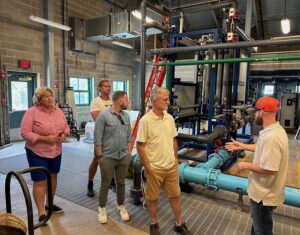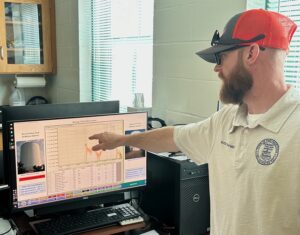Throughout the last year, Provincetown and Truro have been mapping out the infrastructure improvements that will keep the towns supplied with fresh water far into the future.

In presentations last spring, a summer site visit by town officials to the Knowles Crossing treatment plant, and an interview with the Independent this fall, Provincetown Water Superintendent Cody Salisbury explained how the needs in Provincetown and Truro are expected to grow and how the towns can plan for them.
“There’s a lot of scenarios we look at,” said Salisbury, “but we’re focusing on those peak demand days during July and August. How much withdrawal capacity do we have, and how much storage capacity do we have to meet those maximum daily demands?”
Provincetown’s fresh water comes from the Pamet lens in Truro, an aquifer embedded in the giant sandbar that is the Outer Cape. The aquifer itself has plenty of water, said both Salisbury and Jim Vincent, Provincetown’s director of public works. The current limitation is the town’s ability to pump and store water — not the aquifer’s ability to supply it.
“I lived in New Mexico, and that was a problem out there,” said Vincent. “It’s very different here.”

“We’re looking at a capacity issue,” said Salisbury. “Our worst-case scenario is the loss of a wellfield due to mechanical failure and not being able to meet peak demand for a long period of time.”
If the North Union wellfield went offline in the peak period and the backup wells at Truro’s decommissioned Air Force base were unavailable, then the town’s two large storage tanks could make up for the loss for only two days before there was a decrease in pressure at the town’s fire hydrants. In the shoulder season, the spare capacity in the tanks might last for five days, Salisbury said.
The town’s tanks at Mount Gilboa in the East End and Winslow Street in the town center hold 6.4 million gallons of water between them, but almost all of that amount is needed to act as a weight on the town’s gravity-fed water lines to keep them pressurized, Salisbury said. Only a million gallons are free to be used on high-demand summer days.

Adding a tank in Truro would improve pressure there and increase the amount of stored water available on peak days, helping to avoid a crisis similar to the “sewer emergency” that gripped Provincetown for three days in August 2022.
“We want to provide services without anybody knowing we’re here,” said Vincent. “We want to keep the water running and the wastewater working, and those big summer days are challenging.”
The overall withdrawal limit for the existing wellfields is set by the state Dept. of Environmental Protection at 850,000 gallons per day, averaged across the entire year. The wells pump more than double that on the busiest summer days but less than half that in winter. Over the last few years, daily withdrawal has averaged around 660,000 gallons per day, according to Salisbury’s report to the select board in April.
That leaves room for “managed growth” in Provincetown — that is, the controlled addition of homes and commercial uses described in the town’s growth management bylaw — until at least 2040, Salisbury told the select board.
The growth forecast includes the town’s upcoming housing developments at Jerome Smith Road, Maushope, and the former police station as well as three large private users of water: the Barracks dormitory project, the reopening of the Surf Club restaurant, and the redevelopment of 227R Commercial St. The growth management bylaw also allows for another 200 units of affordable housing beyond those projects between now and 2030.
The towns are also planning for significant new demand in Truro. The water dept. serves about 500 Truro accounts, Salisbury said, including the public safety building and the school, but the volume of water supplied to Truro will more than double as the Cloverleaf project, the proposed Walsh property project, the Stone’s Throw condominiums, and a potential expansion of the system to Pond Village come online.
Annual water use will not exceed that allowed by the state permit before 2040, Salisbury said, but the peak summer usage will be even higher than it is now. A demand study by the municipal consulting company Environmental Partners argued for both a new storage tank and a new redundant wellfield by 2040.
“Our finding is that under normal operation you can provide water and you’re not hard-pressed,” Ryan Paul of Environmental Partners told the select board in April. “Once a source goes down, you don’t have a long-term redundant supply.”

Paul said the town should seek to develop a source with about 600,000 gallons per day of pumping capacity — a bit less than the North Union Field wells that came online in 2013.
“Ten years is a realistic estimate for that work,” said Salisbury. “We have to work with Truro to figure out where it would be sited and then there’s field investigations, modeling, and permitting.”
Individual wellfields have physical limits, Vincent said, but the aquifer itself is not running dry.
“If people are talking about our sources running dry — I’m not hearing that,” Vincent said. “Nobody’s said that on any call I’ve been on. This is about developing the systems to get the water to all the users we want to get it to — and that’s complicated enough.
“We’re dealing with the town of Truro and the town of Provincetown, and coming to agreement on anything would require the two towns to work together,” Vincent added. “I don’t want to call it a hurdle — but it will take some effort to get us on the same page and working together on this.”
